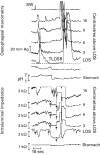Patterns of gas and liquid reflux during transient lower oesophageal sphincter relaxation: a study using intraluminal electrical impedance
- PMID: 9862825
- PMCID: PMC1760051
- DOI: 10.1136/gut.44.1.47
Patterns of gas and liquid reflux during transient lower oesophageal sphincter relaxation: a study using intraluminal electrical impedance
Abstract
Background: Belching has been proposed as a major mechanism underlying acid gastro-oesophageal reflux in normal subjects. However, the presence of oesophageal gas has not been measured directly but only inferred from manometry.
Aims: To investigate, using intraluminal electrical impedance, the patterns of gas and liquid reflux during transient lower oesophageal sphincter (LOS) relaxations, the main mechanism of acid reflux in normal subjects.
Methods: Impedance changes associated with the passage of gas were studied in vitro, and in vivo in cats. Oesophageal manometry, pH, and intraluminal electrical impedance measurements were performed in 11 normal subjects after a meal.
Results: Gas reflux caused a sudden increase in impedance that propagated rapidly to the proximal oesophagus whereas liquid reflux induced a retrogressively propagated fall in impedance. Impedance showed gas or liquid reflux during most (102/141) transient LOS relaxations. When acid reflux occurred, impedance showed evidence of intraoesophageal retrograde flow of liquid in the majority (78%) of events. Evidence of gas retroflow was found in almost half (47%) of acid reflux episodes. When present together, however, liquid preceded gas on 44% of occasions. Overall, gas reflux occurred as the initial event in only 25% of acid reflux episodes.
Conclusions: These findings suggest that in upright normal subjects, although belching can precipitate acid reflux, most acid reflux occurs as a primary event.
Figures








Comment in
-
Gas and liquid reflux during transient lower oesophageal sphincter relaxation.Gut. 1999 Jun;44(6):897-8. doi: 10.1136/gut.44.6.896d. Gut. 1999. PMID: 10375299 Free PMC article. No abstract available.
References
Publication types
MeSH terms
Substances
LinkOut - more resources
Full Text Sources
Other Literature Sources
Medical
Miscellaneous
